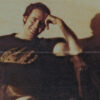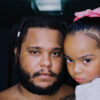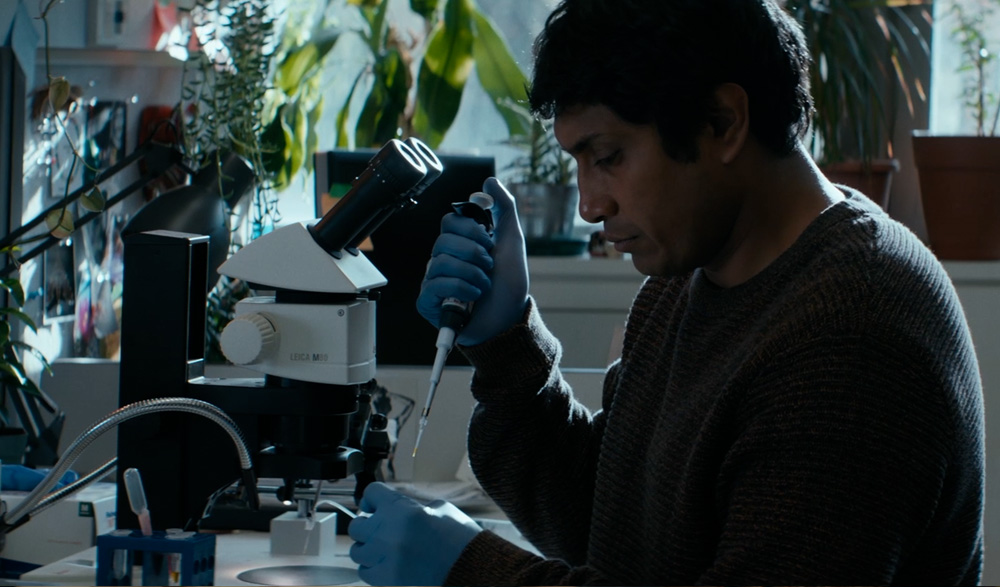It only seems natural now that the beginning of “Son of Monarchs” first took root in Alexis Gambis’ mind upon seeing the end of a journey for monarch butterflies, heading south from Canada to hibernate at the Monarch Butterly Biosphere Reserve in Michoacán, an event that signals fall has arrived to the lush green forest before the leaves start to change. For Gambis, both a biologist and a filmmaker of French-Venezuelan descent, borders have become rather arbitrary and the great migration wasn’t inspiring so much for its sheer size, but for how those butterflies accumulated experiences in their travels without having to consider the limitations that the humans below them had to, leading him to imagine the tale of a scientist studying them who has his own immigration status to worry about.
“The film is in two languages — people speaking English in Mexico or people speaking Spanish in New York — [and I wanted to] merge those worlds to the point of confusion sometimes where you don’t know where you are, you don’t know what time period you’re in and I think my work embraces that multiculturalism,” says Gambis. “As much as we need to tell stories about hardship and a unidirectional arriving to the U.S. and the hope for the American Dream, I wanted my film to easily flow back and forth, emphasizing migration is beautiful and you wake up and you’re in Mexico [or America] and you’re in the past or in the present.”
The fluidity of “Son of Monarchs” makes for a unique cinematic experience, though one that is constantly reminding one of their own humanity as it follows Mendel (Tenoch Huerta), a scientist conducting genome research in New York when he is called back to Mexico to attend his grandmother’s funeral, setting up a confrontation he’s long avoided with his long-estranged brother Simon and making his interest in the gene-editing technology (based on the real-life development of CRISPR) understandable. Caught between two cultures, Mendel is seen no differently by Gambis than the butterflies he studies, continually evolving and marked uniquely by his experiences and the film generously applies such consideration to all of its characters who are never exclusively cast in one particular light, but many as they move through the world.
When Gambis had a policy on set of not dressing any of his scientists in lab coats – after all, that wasn’t his own experience – “Son of Monarchs” is intellectually rigorous without being intimidating, invoking science to tackle a pursuit of answers for questions that one can only answer for themselves as life goes on and the director beautifully marries a number of elements that only can be seen making sense together when he has dared to connect them. With the film making its way onto HBO Max following a celebrated festival run, the renaissance man spoke about how he views his films as experiments, giving his characters multiple dimensions and finding collaborators whose interests and skillsets are as myriad as his.
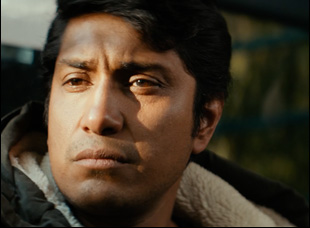
Yeah, I’m definitely interested in animal perspectives and how animals see the world, and because it’s such a complicated task to embark and make a film, I feel like focusing on my attention on an animal and metaphorically dissecting it in many ways and how it relates to us as humans is both a strategy in my writing, but also just an interest that I have, turning to animals for answers, turning to animals for ways to reflect on our own humanity.
My twenties were spent working with fruit flies to study human disease and development, and the insects were larger than life because I was looking at them through microscopes, and [for “Son of Monarchs”], there were many things that attracted me to the monarch. One is it has been, for a while, a symbol for the quintessential migrant — the ability to migrate from Canada through the U.S., arrive in Mexico across borders, every country admires the monarch butterfly. But at the same time, [we’re] killing these insects because of pesticides and roundups and deforestation and human cause of climate change, so [we have this] paradoxical relationship to these monarchs that are migrants.
I have this beautiful poster here that was made by an Argentinian activist where he uses a monarch butterfly and he recreates the patterns in the form of fists and the dots with footsteps, and basically it says “All humans have a right to migrate, all migrants have human rights.” That was definitely one of the catalysts for the interest in monarchs and of course, the science – people studying colors and patterns, like why do we have the skin color that we have? All of these things came about, so I wanted to make a film about an immigrant who identifies with the monarch butterfly and make that story a story about immigration.
You actually made a series of shorts in Mexico that led to making this feature after making your last. Did you actually have a story in mind then or did it evolve?
Because I’m a scientist at heart, a lot of my work starts with investigative research, like ethnographic, anthropological work getting to know people. I make documentaries, but I also made short fictions, a trilogy of short movies called the Monarch Triptych, which explored what does it mean to become a butterfly? What does it mean for a scientist in New York that is dealing with a DACA repeal in the prior administration and she turns into a butterfly in New York City and walks around as a butterfly – that’s called “She Who Dreams” in reference to the DREAMers. Then I made a film about two clowns in Mexico that are the last two monarch butterflies on the planet, and I made another called “Mi Hermano (My Brother),” about a boy who is waiting for his brother who passed away to come back as a butterfly, but never arrives because of climate change. So all of my work starts out with a process of understanding the environment that I’m in – the people, the characters — and then creating these fictional worlds, bu that also helps me get the interest [in financing a feature], get the actors, get the proper partners.
Is it true you found Tenoch in that time?
Definitely, I met Tenoch through the process of making these short films through a common friend, and in a way, [“Son of Monarchs”] is a little bit my story because I was also in my twenties, working in a lab, helping with family tragedy and trying to figure out who I was. So I invited him to Michoacan to see the short films and we had the whole town come to a school auditorium to watch the short films. He was really interested in the role and the science and evolution [aspect], but I think what sold him was to go there and see people react to the short films and visiting the butterfly sanctuary. He became a real partner-in-crime in terms of developing the role, learning about how to work with the microscope, and he definitely helped in getting other actors and in the writing process because I was still writing. He embodies both this kind of introverted aspect of trying to figure out who we are, but also being outspoken as well and [when] he doesn’t speak much on camera, it was important for there to be a symbiotic relationship between the [actor] and the director.
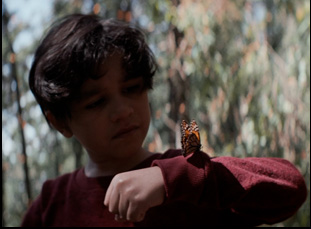
Well, everybody in New York has crazy occupations. Even today, someone said, “Oh, I’m going to go rock climbing in Brooklyn on the weekend…” and actually, a lot of people that I met at the trapeze school were scientists and architects, so I loved having this element of being involved in human rights, but also I wanted her to be a free spirit and inhabit these kind of activities. He’s very closed-off and she flies – in a very literal sense, she spends her free time on a trapeze and enjoying it and not really overthinking it, so it was interesting to have her be that counterpoint of somebody who would be a nice companion for him and she kind of floats around him. The film is not really about the relationship, but she has this energy and allows him to understand things about himself.
The ability to be many different things extends to your crew – is it true your sound recordist is also a molecular biologist?
Yeah, I met Andres [Saldana] in one of the short films through a common friend. I’m surrounded by a lot of people that have an interest in science and art because I run a science/film organization in New York [LABOCINE] and there’s a lot of us out there. Andres’ interest in the science of sound and capturing the sound of the laboratory, but also the sound of the butterflies – all of this was definitely definitely a big part [of the film]. And a lot of my films start out with thinking about sound before visuals because I feel like sound allows us to capture the world in a more discreet, less aggressive way. Once you start introducing cameras, you’re at a whole other register of people behaving, so I try to delay the camera as much as possible.
You’ve actually likened science to music in the way that it can underline the film. How does it make its way in?
Yeah, I definitely refer to science as the music in my films because my films are not really science films, although I don’t really know what that term means. They just tend to explore scientific ideas, but my approach to science is that I’m not so interested in delivering a message. I like it being the music in the background, playing in the background of the world that you’re witnessing, so whether it’s seeing him working in a lab, maybe some voiceover where [Mendel’s] speaking about genetics, it’s poetry and enriches the experience for the viewer. Also I love the technical terms in science, just like people being so fascinated about what they work on that they may speak about it in words we may not understand as if they were musicians or they were architects. I also love the fact that people can speak about science in different languages – describing genetics and DNA in another language other than English, so that’s how I approach science. I’m not so focused on you having to understand everything, but if you can passively ingest it through sound and through visuals then I’m happy.
You move so seamlessly through time and space and you can feel how experiences build on one another — was that idea of layering foundational or did it evolve throughout the process of editing this?
It was a little bit more linear in the writing process because I was a little bit apprehensive that maybe it’s a little bit hard to read when things go back and forth so constantly, but I realized in the editing with my editor Elia [Gasull Balada] that the film is about memory and reconstructing identity, so it made sense to have this fractured structure to it and that came progressively. There was the original idea there, but how do you cross time, how do you change time through the microscope, through the dreams, through the butterflies — a lot of that was finessed in the production and the editing process. It wouldn’t work for every film because my film is about trying to figure out who you are, and there’s a very important expression in biology, which is structure dictates function. We oftentimes say that for proteins or for example, for COVID, the structure of it tells us what it does because we don’t fully understand molecules. I think that can also be translated into the way you structure a film. It can be informed by what you’re trying to say. That sounds relatively basic and straightforward, but it goes beyond the editing, it goes into mixing documentary/fiction and dreams [and reality] — all of that is informed by what the characters are going through and the objectives that you have for them.
What’s it like reaching the finish line yourself with this?
When you work on something for so long and and the feeling of it being on the marquees of the cinemas in New York, I was just walking by [a theater], they have it next to the movie “Dune” and it’s just an amazing experience. More than anything since Morelia and then Sundance, just the fact that people can identify with the story is what affects me the most. What I really love is this comment that keeps coming from people, which is that the movie sticks with them. It stays in their mind and it’s a film that has a lot of layers, which sometimes may be a little hard to digest, but you think about it and think about yourself. Right now I think questions about where we belong and immigration are really important and of course, representation of Latinos like myself in cinema that are different than the ones we usually see, like scientists and artists, are really important because it’s the reality of the landscape here in the U.S.
“Son of Monarchs” is now streaming on HBO Max.

